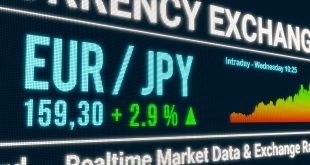
Government Bonds Face Intensified Challenges in the US and Europe in May 2025
Soaring Debt Levels Threaten Fiscal Stability
In May 2025, government bonds in the US and Europe are under intense pressure from unprecedented debt burdens and concerns over fiscal sustainability. As of March 2025, US national debt stands at $36.56 trillion, or roughly 126% of GDP, with projections suggesting it could exceed 130% by year-end—a level associated with default risks in 98% of countries since 1981. The US Treasury plans to issue $514 billion in new debt in Q2 and $554 billion in Q3 to finance a $2 trillion deficit, with $9.2 trillion in debt maturing this year, much of it short-term. Refinancing at higher yields has driven annual interest costs to $952 billion, surpassing defense spending and crowding out other budgetary priorities. In Europe, France’s political crisis, marked by a no-confidence vote and budget disputes, has pushed its 10-year bond spread over German bunds to a 2012 peak of 108 basis points. Germany’s consideration of easing its debt brake could increase borrowing, with €450 billion in Eurozone debt issued in Q1 2025 alone. Investors everywhere articulate this sentiment, voicing alarm over governments’ ability to manage deficits without destabilizing markets.
Trade Tensions Amplify Inflation Risks
US tariff policies are fueling bond market volatility. President Donald Trump’s proposed 50% tariff on EU imports, announced in May 2025, initially spiked yields due to fears of imported inflation. A temporary tariff reduction extended to July 9, 2025, eased concerns, but uncertainty persists, particularly with ongoing US-China trade frictions. Europe’s export-driven economies, like Germany, face heightened inflation risks, which could depress bond prices if central banks delay tightening. Investors everywhere articulate this sentiment, noting that the US 10-year Treasury yield hit 4.465% on May 27, 2025, reflecting inflation fears. Higher yields erode the value of existing bonds, making new issuances at Eurozone 10-year yields averaging 3.8% more attractive but challenging for current holders.
Central Bank Caution Fuels Rate Uncertainty
Monetary policy remains a critical challenge. The US Federal Reserve paused rate cuts in early 2025, with markets pricing in just 100 basis points of easing for the year, down from earlier expectations, as core PCE inflation holds at 2.9% with forecasts of 4.2% by Q4. This suggests sustained high rates, increasing borrowing costs. In Europe, the European Central Bank faces pressure to cut rates to counter sluggish 0.8% growth, but France’s instability and Germany’s fiscal shifts complicate decisions. Investors everywhere articulate this sentiment, citing the difficulty of navigating rising yields amid divergent US and European policies, with ECB interventions potentially capping yields. The 30-year US Treasury yield breaching 5.02% in May signals persistent unease.
Bond Vigilantes Enforce Market Discipline
The resurgence of “bond vigilantes”—investors selling bonds to protest fiscal profligacy—is intensifying. In the US, Moody’s downgrade of the US credit rating on May 16, 2025, intensified fiscal crisis fears, pushing 30-year Treasury yields to 5.13%. This followed Trump’s deficit-expanding budget bill, projected to add $3.3 trillion to the debt over a decade. In Europe, UK 10-year gilt yields hit 4.6% in May, a 2008 high, while German bund yields rose 60 basis points since December 2024 to 3.4%. Investors everywhere articulate this sentiment, warning that frequent debt refinancing, with US auctions showing weak bid-to-cover ratios of 2.4 for 30-year bonds, risks market turbulence if confidence erodes.
Foreign Demand Shifts and Safe-Haven Trends
Foreign investor dynamics are reshaping bond markets. In the US, a “foreign buyer’s strike” is emerging, with China holding $1.9 trillion in Treasuries potentially selling amid trade disputes, fueling a “Sell America” trend. This has weakened demand, with foreign holdings at 27% of the $9.9 trillion marketable securities market. Conversely, German bunds are gaining as a safe haven, with yields dropping to 2.9% as investors flee US volatility. Japanese insurers, managing $2.1 trillion in assets, are shifting to European bonds, further pressuring US yields. Europe’s bond demand remains strong, with €810 billion in orders for €73 billion in January sales. Investors everywhere articulate this sentiment, highlighting Europe’s rising safe-haven status against the US’s struggle to retain investor trust.
Strategic Risks and Investor Navigation
The debt crisis poses strategic risks, particularly for the US, where interest payments now exceed $952 billion annually, limiting fiscal flexibility and raising national security concerns. Budget cuts could undermine US global influence. In Europe, political fragmentation threatens bond stability, though ECB interventions may mitigate risks. For investors, short-duration US Treasuries hedge against yield spikes, while European bonds offer safety. Morgan Stanley warns that 2025 bond returns depend on central banks’ ability to cut rates amid 4.6% inflation projections, a high-risk scenario. Investors everywhere articulate this sentiment, urging caution in a volatile bond market where strategic positioning is essential to balance yield and risk.
 Noor Trends News, Technical Analysis, Educational Tools and Recommendations
Noor Trends News, Technical Analysis, Educational Tools and Recommendations




